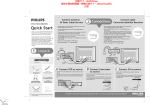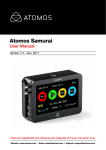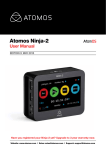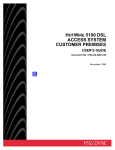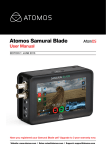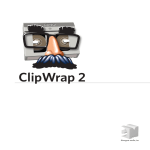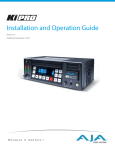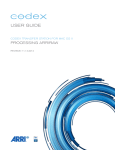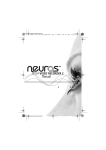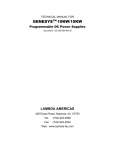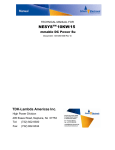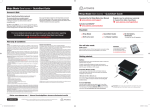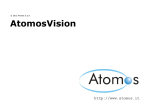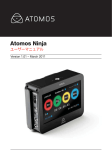Download Atomos Ninja. User Manual
Transcript
Atomos Ninja User Manual Version 1.0 – March 2011 Have you registered your Ninja yet? Upgrade to 3 year warranty* now. Website: www.atomos.com | Sales: [email protected] | Support: [email protected] Contents Safety Instructions Warranty & Conditions . . . . . . . . . . . . . . . . . . . . . . . . . . . . . . . . . . . . . . . . . . . . . . . . . . . . . . . . . 1 Introduction . . . . . . . . . . . . . . . . . . . . . . . . . . . . . . . . . . . . . . . . . . . . . . . . . . . . . . . . . . . . . . . . . . . . . . . . . 2 1. What’s included. . . . . . . . . . . . . . . . . . . . . . . . . . . . . . . . . . . . . . . . . . . . . . . . . . . . . . . . . . . . . . . 3 2. What you also need . . . . . . . . . . . . . . . . . . . . . . . . . . . . . . . . . . . . . . . . . . . . . . . . . . . . . . . . . 3 What drives should you use . . . . . . . . . . . . . . . . . . . . . . . . . . . . . . . . . . . . . . . . . . . . . . . 3 Solid Sate Drives (SSDs) . . . . . . . . . . . . . . . . . . . . . . . . . . . . . . . . . . . . . . . . . . . . . . . . . . . . 3 Mechanical Vibration . . . . . . . . . . . . . . . . . . . . . . . . . . . . . . . . . . . . . . . . . . . . . . . . . . . . . . . . . 3 Backing up and archiving . . . . . . . . . . . . . . . . . . . . . . . . . . . . . . . . . . . . . . . . . . . . . . . . . . 3 HDMI Cables . . . . . . . . . . . . . . . . . . . . . . . . . . . . . . . . . . . . . . . . . . . . . . . . . . . . . . . . . . . . . . . . . . . . 4 3. Mounting disks in the Master Caddy . . . . . . . . . . . . . . . . . . . . . . . . . . . . . . . 6 4. Connecting and powering up. . . . . . . . . . . . . . . . . . . . . . . . . . . . . . . . . . . . . . . . . . . 7 Batteries. . . . . . . . . . . . . . . . . . . . . . . . . . . . . . . . . . . . . . . . . . . . . . . . . . . . . . . . . . . . . . . . . . . . . . . . . . . 7 AC Power Adaptor . . . . . . . . . . . . . . . . . . . . . . . . . . . . . . . . . . . . . . . . . . . . . . . . . . . . . . . . . . . . 3 Power ON / Power OFF . . . . . . . . . . . . . . . . . . . . . . . . . . . . . . . . . . . . . . . . . . . . . . . . . . . . . 3 5. Ninja connections. . . . . . . . . . . . . . . . . . . . . . . . . . . . . . . . . . . . . . . . . . . . . . . . . . . . . . . . . . . . 8 6. Other physical features. . . . . . . . . . . . . . . . . . . . . . . . . . . . . . . . . . . . . . . . . . . . . . . . . . . . 8 Master Caddy – Insert/Eject . . . . . . . . . . . . . . . . . . . . . . . . . . . . . . . . . . . . . . . . . . . . . . . 9 Screw mounts. . . . . . . . . . . . . . . . . . . . . . . . . . . . . . . . . . . . . . . . . . . . . . . . . . . . . . . . . . . . . . . . . . . 9 7. Using the Ninja. . . . . . . . . . . . . . . . . . . . . . . . . . . . . . . . . . . . . . . . . . . . . . . . . . . . . . . . . . . . . . . 10 The User Interface in detail. . . . . . . . . . . . . . . . . . . . . . . . . . . . . . . . . . . . . . . . . . . . . . . . 10 Ninja’s Touchscreen. . . . . . . . . . . . . . . . . . . . . . . . . . . . . . . . . . . . . . . . . . . . . . . . . . . . . . . . . . 10 The Home Screen. . . . . . . . . . . . . . . . . . . . . . . . . . . . . . . . . . . . . . . . . . . . . . . . . . . . . . . . . . . . . 10 Batteries Screen. . . . . . . . . . . . . . . . . . . . . . . . . . . . . . . . . . . . . . . . . . . . . . . . . . . . . . . . . . . . . . . 12 Auto Switching/Manual Switching. . . . . . . . . . . . . . . . . . . . . . . . . . . . . . . . . . . . . . 12 8. Monitoring and Recording. . . . . . . . . . . . . . . . . . . . . . . . . . . . . . . . . . . . . . . . . . . . . . 14 Connect to Input . . . . . . . . . . . . . . . . . . . . . . . . . . . . . . . . . . . . . . . . . . . . . . . . . . . . . . . . . . . . . . 14 Before recording. . . . . . . . . . . . . . . . . . . . . . . . . . . . . . . . . . . . . . . . . . . . . . . . . . . . . . . . . . . . . . . 14 Anti-shock technology. . . . . . . . . . . . . . . . . . . . . . . . . . . . . . . . . . . . . . . . . . . . . . . . . . . . . . 15 9. Connecting and Editing . . . . . . . . . . . . . . . . . . . . . . . . . . . . . . . . . . . . . . . . . . . . . . . . . . 15 Connect to Input . . . . . . . . . . . . . . . . . . . . . . . . . . . . . . . . . . . . . . . . . . . . . . . . . . . . . . . . . . . . . . 14 Importing Ninja Footage into Final Cut Pro . . . . . . . . . . . . . . . . . . . . . . . . . 14 Anti-Shock Technology. . . . . . . . . . . . . . . . . . . . . . . . . . . . . . . . . . . . . . . . . . . . . . . . . . . . . 15 10. Software Upgrades. . . . . . . . . . . . . . . . . . . . . . . . . . . . . . . . . . . . . . . . . . . . . . . . . . . . . . . . 15 Updating ATOM-OS (Firmware) . . . . . . . . . . . . . . . . . . . . . . . . . . . . . . . . . . . . . . . . . 17 Problems when installing Firmware. . . . . . . . . . . . . . . . . . . . . . . . . . . . . . . . . . . . 17 The Ninja is designed to a high standard but there are some things you should be aware of to prolong the life of the unit and for your own safety. 11. Technical Specifications. . . . . . . . . . . . . . . . . . . . . . . . . . . . . . . . . . . . . . . . . . . . . . . . 18 Conventions To keep things simple but clear, we’ve only adopted two conventions in this manual: Batteries and power supplies The batteries supplied with the Ninja are powerful, professional devices, designed to retain enough energy to supply the Ninja for hours. You should avoid short-circuiting the battery connections because this can cause a high current to flow which can damage the cells and even pose a fire hazard. For example, you should not carry batteries in a bag or pocket where they may contact other metal objects such as coins. The power supply and battery charger included are intended for use with the Ninja and nothing else. Keep the power supply, plug and cable away from water and unplug from the mains electricity socket when not in use. Disconnect power supplies before cleaning the Ninja or its components. Using the Ninja safely Although the Ninja is very lightweight compared to all the devices it replaces, it is still a solid object that could cause injury if misused. • Always make sure that the Ninja is mounted securely and is unable to fall onto anyone nearby. This is especially important when there are children present who might be tempted to pull on cables. • Always ensure that cable runs to the Ninja are clearly visible and do not present a trip hazard. • Do not place on uneven or unstable surfaces. • Do not insert anything but Ninja Master Disk caddies in the Master Disk slot on the side of the Ninja. • Do not touch the Ninja’s screen with sharp, metallic or abrasive objects. • The Ninja can become warm or hot with prolonged use. Do not place it in contact with your lap or any part of your body where such warming could cause discomfort or injury. • Do not expose to strong electrical or magnetic fields. • Do not expose to or use near liquids, rain or moisture. • Do not dispose of the Ninja or its batteries in municipal waste and do not incinerate it or its batteries, but follow local regulations for safe disposal Care of disk drives Spinning disks and SSDs are very sensitive to damage from static electricity. Please observe all the usual precautions when handling them. Please see the section Mechanical shock and vibration later in this manual for information about how to handle and care for your disk drives. Small parts The Ninja carry-case contains small parts that could be a choking hazard for small children. A helpful tip, suggestion or something to note because it’s not obvious at first Menu Monospaced text indicates a menu or touch action Important note about disk types: HDD/SSD/Disk Drives etc To avoid any confusion, when we’re talking about “traditional” spinning disk drives, we’ll refer to them as “spinning disks”. Solid-state drives we’ll refer to as “SSDs” (Solid State Drives).When we want to refer to both types of drive, we just call them “disks”. Atomos Ninja. User Manual V1.01 2 Warranty & Conditions Notice Software License Agreement Copyright © 2011 ATOMOS Global Pty Ltd (‘referred to as ATOMOS’). All rights reserved. All information in this document is subject to change without notice. No part of the document may be reproduced or transmitted in any form, or by any means, electronic or mechanical, including photocopying or recording, without the express written permission of ATOMOS. A reference to ATOMOS includes its related entities, subsidiaries and parent company. IMPORTANT, PLEASE READ CAREFULLY. THIS IS A LICENSE AGREEMENT. This ATOMOS software, related documentation, any included sample images and other files (the “Software”), is protected by copyright laws and international copyright treaties, as well as other intellectual property laws and treaties. The Software is licensed, not sold. Trademarks NINJA, ATOMOS are registered trademarks of ATOMOS, Apple, the Apple logo, AppleShare, AppleTalk, FireWire, iPod, iPod Touch, Mac, and Macintosh are registered trademarks of Apple Inc. Final Cut Pro, QuickTime and the QuickTime Logo are trademarks of Apple Inc. All other trademarks are the property of their respective holders. International Hardware Limited Warranty ATOMOS warrants that: • the main product, not including TFT/LCD, or any external accessories, will be free from defects in materials and workmanship for a period of 1 years from the date of purchase, the user may upgrade to a 3 year warranty upon registering their product at www.atomos.com • the TFT/LCD, batteries, battery charger and HDD/SSD docking station will be free from defects in materials and workmanship for a period of 1 year from the date of purchase. This warranty is exclusively for the benefit of the original purchaser and is not assignable or transferable. If during the warranty period the product is shown to be defective ATOMOS may at its option: a) replace the goods or supply equivalent ones, b) repair the goods, c) pay the cost of replacing the goods or of acquiring equivalent ones and d) paying the cost of having the goods repaired; The customer must notify ATOMOS of any defect in the goods in writing prior to the expiry of the warranty periods set out above. The customer will be solely responsible for returning the goods to ATOMOS or its authorized distributor. Upon acceptance of a warranty claim by ATOMOS, where ATOMOS repairs or replaces the goods, it will be responsible for reasonable shipping costs incurred in sending the goods to the Customer, provided that customer is located in a country in which ATOMOS has an authorized distributor or repair centre or agent. Warranty Exclusions This warranty applies only to defects in workmanship and does not cover defects caused by: • A failure to comply with the then current operating instructions issued by ATOMOS; • Neglect; • Improper or negligent acts or omissions; • Unauthorised repairs or attempted repairs; • Tampering with or modification of the goods; • Connection to incompatible equipment or power sources; • Exposure to water or weather; • Exposure to magnetic fields or corrosive liquids or substances; This End User License Agreement (“EULA”) is a legal agreement between you (either an individual or a single entity) and ATOMOS with regard to the copyrighted Software provided with this EULA. Use of the Software provided to you by ATOMOS in whatever form or media, will constitute your acceptance of these terms, unless separate terms are provided by the software supplier, in which case certain additional or different terms may apply. If you do not agree with the terms of this EULA, do not download, install copy or use the Software. By installing, copying or otherwise using the Software, you agree to be bound to the terms of this EULA. If you do not agree to the terms of this EULA, ATOMOS is unwilling to license the Software to you. 1.Eligible licensees. This Software is available for license solely to purchasers of the ATOMOS Ninja, who have purchased a unit manufactured by ATOMOS Ninja and purchased through an ATOMOS authorized reseller, with no right of duplication or further distribution, licensing or sub-licensing. 2.License Grant. ATOMOS grants you a personal, non-transferable and non-exclusive right to use the copy of the Software provided with this EULA. You agree you will not copy the Software except as necessary to use it with the ATOMOS Ninja. You agree that you may not copy the written materials accompanying the Software. Modifying, reverse engineering, translating, renting, copying, transferring or assigning all or part of the Software or any rights granted hereunder, to any other persons or reverse engineering the hardware on which the Software runs, is strictly prohibited. The software is license, not sold. You acknowledge that no title to intellectual property in the Software is transferable to you. You further acknowledge that title and full ownership rights to the Software will remain the exclusive property of ATOMOS and/or its suppliers, and you will not acquire any rights to the Software, except as expressly set forth above. All copies of the software will contain the same proprietary notices as contained in or on the Software. All title and copyrights in and to the Software (including but not limited to any images, animations, video, audio, text incorporated), the accompanying printed materials, and any copies of the Software are owned by ATOMOS or its suppliers. 3.Reverse engineering. You agree that you will not attempt, and if you are a corporation, you will use your best efforts to prevent your employees and contractors from attempting to reverse compile, derive circuits, modify, translate or disassemble the Software and/or the Atomos Ninja in whole or in part. Any failure to comply with the above or any other terms and conditions contained herein will result in the automatic termination of this license and the reversion of the rights granted hereunder by ATOMOS. ATOMOS reserves the right to terminate this license without prejudice to any additional recourse ATOMOS may have against you if you violate any of its terms and conditions. EXCEPT AS STATED IN THIS WARRANTY, ATOMOS, IT’S VENDORS, AGENTS, RESELLERS AND DISTRIBUTORS DISCLAIM IN THEIR ENTIRETY ALL OTHER WARRANTIES, EXPRESS OR IMPLIED, INCLUDING WITHOUT LIMITATION ALL WARRANTIES OF MERCHANTABILITY OR FITNESS FOR A PARTICULAR PURPOSE. THE REMEDIES OUTLINED IN THIS WARRANTY ARE THE EXCLUSIVE REMEDY A CUSTOMER HAS ARISING FROM DEFECTIVE GOODS WHICH ARE SUBJECT TO THE WARRANTY. ATOMOS DOES NOT WARRANT THAT THE GOODS WILL OPERATE IN A MANNER WHICH IS ERROR FREE, OR UNINTERRUPTED. THE GOODS ARE NOT INTENDED TO BE THE PRIMARY OR ONLY DATA STORAGE DEVICE FOR DATA – CUSTOMERS ARE SOLELY RESPONSIBLE FOR BACK UP AND PROTECTION OF DATA. Atomos Ninja. User Manual V1.01 1 Introduction Your Ninja comes with a standard 1 year warranty on all parts and accessories. You can upgarde to a 3 year warranty on the Main Ninja Unit alone (exluding TFT/LCD) by registering your Ninja online at www.atomos.com/ninja/registration. This will enable us to let you know about updates to the product and other important information surrounding your purchase. Ninja solves this by using Apple ProRes® compression. It’s much kinder to your video, because it doesn’t compress it as much. By using 6, 8 or 10 to 1 compression instead of 20 or 30 to 1, its much better for editing, because it doesn’t have lots of frames that have to be reconstructed from other frames. Every frame is there in full. It’s the fastest, and best-quality workflow possible today. So, because it doesn’t compress as much, it needs more storage. And - because of the plummeting price of hard disk storage - (it’s tens of thousands of times cheaper than it was just fifteen years ago!) - the 2½” disks used by the Ninja are very cheap. The cost of storage is no longer an issue. Buying a disk for the Ninja is just like buying a tape - except that with a disk, you have instant, random (“Non-Linear”) access to your material, this eliminates the need for log-and-capture using a standard capture card. The reason that Ninja exists at all is because of the relentless march of technology, and the way that this changes the economics of almost everything. Most of all, though, it changes the way you use storage. Ninja is easy to use, so this isn’t a long manual. We will issue software updates for your Ninja on a regular basis. Please keep an eye on www.atomos.com/ninja to see if any upgrades are due. Built-in (or card-based) camera storage is a miracle of science; but that doesn’t stop it being expensive when you use it with HD video. Video takes up so much space — So you have to compress it. We hope you enjoy your Ninja. Thank you for buying an Atomos Ninja: your 10bit Production Weapon for HDMI-equipped cameras. It’s going to transform the way you work with video. Ninja preserves the pristine uncompressed video quality from your camera’s sensor by encoding it into Apple ProRes® directly. Then it goes straight to the timeline of your NLE. Even though MPEG compression like h.264 and MPEG-2 are very clever technologies, they’re nowhere near perfect, and they certainly weren’t designed for the rigours of editing. ® Atomos Ninja. User Manual V1.01 2 1. What’s included Your Ninja arrives as a complete system: you don’t have to add anything except 2.5” storage media (you can buy additional packs of empty Master Disk Caddies from your Atomos Reseller) and some cables to suit your set-up like HDMI. All other parts necessary to use the Ninja (including cables) are included in the carry case. Here’s the complete list Atomos does not sell storage and your package will not contain any spinning disks or SSDs. You can buy these locally to keep running costs as low as possible. We recommend drives, please refer to Part 12 (Technical Specifications) of this manual. For the most up-to-date information please visit: www.atomos.com/ninja/HDDSSDSupport.pdf • Ninja body (the Ninja itself, with touchscreen, inputs and slot for Ninja disk caddies) • 2 x empty Master Disk Caddies + 8 Screws for fixing disks • Master Caddy Docking Station with a. USB 2 & 3 Cable Under dock b. Firewire Cable Under Ninja body c. USB 2.0 power cable under dock for extra USB power when required • Battery Charger with Power Supply Unit located underneath • 2xAtomos 7.4 V 2600milliAmp-hour(mAh)Batteries • Ninja Carry Case • Ninja Quick Start Guide (not pictured) Atomos Ninja. User Manual V1.01 3 2. What you also need 2 ½” Disk Drives These are the raw storage medium for Ninja. You can use either traditional “spinning” disks, or the new solid state ones. Choose spinning drives if your Ninja is going to be attached to a tripod or if it is not going to be subject to excessive vibration. For harsher conditions, choose a solid state drive. Which drives should you use? There are so many drives available, and new models appear all the time. Speed and reliability are the main factors. Some tips on working with disks • Disk drive data rates tend to be given in megaBYTES per second, and codec data rates are normally given in megaBITS per second. It’s very easy to get confused. But there’s no need to be, because all you have to do to convert megabits to megabytes is divide by 8. So if you’re recording at 220 megaBITS per second, that’s going to result in 220/8 megaBYTES per second, which is 27.5 megaBYTES per second. • To see what works for you, you may want to start working with relatively fast drives 7200 RPM, and then try slower ones 5400 RPM. This gives you a frame of reference for comparison. Just remember that the higher the bitrate of the Apple ProRes® you’re using, the faster the drive needs to be. Solid State Drives (SSDs) These are Flash memory devices that come in the same form-factor as 2 ½” disk drives, and they are fully supported by the Ninja. See the section below about when you should consider using SSDs. We only recommend Intel SSDs at this stage as we have had unreliable results from all other drives. Mechanical Shock and Vibration Here are some things that you should bear in mind when using spinning disks: • Even though spinning drives can withstand substantial shocks when they are not in use, they are more vulnerable when running. Harsh treatment that may not actually damage the drive may interrupt recordings at a much lower level of severity. We recommend that you experiment with your drives by testing them in the conditions that you normally work in. • Spinning drives have a gyroscopic effect that you will feel faintly if you rotate the Ninja up or down or from side to side. They are particularly sensitive to this type of motion. If you do this too quickly while the drive is spinning, you may get a small gap in your recording. • Be very gentle when changing batteries if you are recording. Practise this manoeuvre so that you are able to do it smoothly. It is always better to do this in-between takes. • Do not bang or jolt the Ninja while recording. Gentle and cushioned movement may be OK. • You will find enormous differences in the ability of drives to withstand shock and to continue recording during vibration and movement. As we receive reports of drive durability and reliability, we will post them on www.atomos.com • Your Ninja is able to detect when the drive is under stress and it will recover from any break in a recording by waiting until the drive is ready to continue, and then resuming from that point. If frames have been dropped because of shock or vibration, a “Skippy” Kangaroo symbol will appear on the home screen on the Ninja, just above the disk capacity indicator. This means that you will not normally have to restart the Ninja, even if a recording has been interrupted by mechanical disruption to the disk drive. (see Recording and Monitoring: Atomos Anti-shock Technology for more information) Hard disks are precision mechanical devices that need to be handled carefully. You will be using the same type of drives that are normally used in notebook computers, and you can use this as a guide to whether you need to use mechanical drives or Solid State ones for any proposed projects. If you think a particular usage scenario would be suitable for a notebook computer, then it will probably be OK for a mechanical drive inside a Ninja. If you think the drive inside your notebook might suffer damage, then don’t use a mechanical drive. Taking into account most usage scenarios, we think that mechanical disks will be suitable in the majority of cases. Spinning disks are most sensitive when they are rotating. It is obviously best to avoid dropping them but many disks now have a “drop detector” that will lock the most fragile mechanical parts in place and protect them from surprisingly hard knocks. We recommend that if you want to experiment with this, you do so with a drive that doesn’t contain the day’s shoot! We can’t give rigid guidelines because there are so many different kinds of drives, each with different mechanical properties. You may even find variations between drives of the same type. Backing up and archiving What we have found is that mechanical drives are suitable for most purposes that don’t involve harsh vibration or mechanical shocks. They will be perfect for tripod-mounting, and also for the majority of hand-held work. We would advise against hard-mounting them on moving vehicles (but they would probably be OK if cushioned against the body of the camera operator) and we would not advise using mechanical disks if there is a likelihood that they might be dropped onto a hard surface. Remember that no storage medium, including tape, optical disks, spinning disks and flash memory, is completely immune from failure. You should bear this in mind when deciding how to manage your recorded content. At the very least, you should consider the consequences for you and your business if your storage medium were to suffer from a sudden failure, and you should back up your content accordingly. Hard drives that you can use for archiving are becoming increasingly affordable. You may find that it is completely feasible for your to keep your master Ninja disks on a shelf (just like tapes!), and, as a backup, store copies on large hard drives, RAID arrays or Network Attached Storage (NAS). Atomos Ninja. User Manual V1.01 4 2. What you also need cont. HDMI cables (not included) There’s a lot of mythology about HDMI cables. Most people can’t tell the difference in picture quality between expensive ones and cheaper ones. There shouldn’t be any difference if as long as all the digits going through the cable arrive at the other end. And yet some supposedly “top end” cables can cost hundreds of times more than you necessarily have to spend. It is rare to get a cable that is bad enough to affect the picture, but keep in mind that the longer the cable, the more likely it is to cause problems. That’s completely different to the type of use they will get with the Ninja, when they will be moved all the time and need to be strong but flexible. Some of the cheaper HDMI cables might work properly but are almost completely inflexible. Flexible cables will put less strain on the HDMI sockets on your camera and on your Ninja - but, in any case, it is worth considering some kind of cable management (cable ties or clips) near each HDMI socket especially since HDMI is not a “locking” connection. Some cameras and camcorders use a “mini” HDMI connection to save space. Cables with a mini connection at one end and a standard one at the other end are freely available. There is at least one good reason for spending a bit more on an HDMI cable: the physical quality. If the HDMI cable is removed while recording the “Skippy” image will also be displayed. To remove touch skippy and he will disappear ready for his next notification. HDMI was designed as a living-room standard. So most cables are designed to be fitted behind TVs and rarely moved. Refer to Part 8: Atomos Anti-skip Technology for more information about “Skippy”. Atomos Ninja. User Manual V1.01 5 3. Mounting disks in the Master Caddy Mounting drives in the Master Caddy This is simplicity itself. Just insert the disk into the caddy, and secure with four screws. The caddy is light and the disk just needs to be held securely. Don’t over-tighten the screws. There are no connections to make because pushing the caddy into the Ninja or the Docking station makes all the connections for you. Spinning disks and SSDs are very sensitive to damage from static electricity. Please observe all the usual precautions when handling them, especially DO NOT EVER touch the exposed SATA connector as static electricity may be harmful to your disk. The Master Caddy can’t be inserted the wrong way round. Always make sure that the disk connector faces the slot in the Ninja. You have to be quite firm to push the Master Caddy into place, but don’t push too hard, just in case something isn’t set up or aligned properly. There is very little that can cause problems and the most likely thing is that the Master Caddy isn’t properly flush with the drive inside. A quick visual check will confirm this. 1 Carefully assemble the Master Caddy and disk Insert screw Align all parts 2 Insert screw Ensure all 3 parts aligned and insert 4 x screws (supplied) Do not over-tighten screws or alignment can not be guaranteed. We suggest squeezing the corners together near the screw you are tightening for optimal fit. Atomos Ninja. User Manual V1.01 6 4. Connecting the Ninja and powering up Batteries Battery number 1 Gently slide down into battery slot/s and lock into position. Push latch to release battery The Ninja is a battery powered device, and has a special feature to ensure that you never have to interrupt a recording to change a battery. We will come to this shortly. Like all batteries, you will need to take care of them. Make sure that you don’t short circuit the connections because this can result in very high currents that can damage the cells and could pose a fire hazard. Charge new batteries before using them. The supplied Ninja charger can charge two batteries simultaneously. There are four red LED indicators for each battery. This will show the approximate stage the charging process has reached. Batteries do not charge in a linear way. At first they charge very quickly, and then the rate slows down to a trickle. While charging, one or more red lights will blink. When 90% charge is reached, all the lights will flash. It is perfectly OK to use the batteries at this point and we recommend stopping at this stage for the longest battery life. If you leave the batteries on charge after all four lights are flashing, the charger goes into trickle charging mode for the final 10%. Eventually, when trickle charging is complete, and the batteries are at 100% charge, all the lights will go out. for the first battery. This is effectively your Always use battery slot primary battery and the Ninja will not start without it. Battery slot No.2 is the secondary or back-up battery and is not marked. Once the Ninja has been started from battery slot No. 1, it will operate on battery slot No. 2 alone. No. 1 is only required for start up. To insert the batteries, gently slide them down into the slot and lock them into position. To remove a battery, push the latch to release it. Each battery has its own latch, which is located to the right of batter No. 1 and to the left of batter No. 2 as you look at the back of the Ninja. Pull the latches towards the batteries to release them. Ninja batteries are held in place very tightly because they are on the outside of the device and there has to be no possibility whatsoever that they could work loose, so you will have to be quite firm with the battery latches. We suggests that you familiarise yourself with the force required to remove the batteries so that you can do this quickly in the field. Make sure that you hold the top and the bottom of the battery when sliding it off to avoid dropping the battery when it is released from the main unit. The Ninja introduces an Atomos technology called Battery Looping for continuous power. When power is running low on one battery, the Ninja will automatically switch to the second battery, you can remove one of the batteries and replace it with a fully charged one. Ninja will continue to operate as you do this. You can continue this process indefinitely. Ninja Battery Looping circuit will not operate if an AC adaptor is attached. You can purchase a Sony NP Series 8.4V AC adaptor (used by Sony Cameras) that have the same NP series battery plate. WARNING: Do not connect batteries or AC Adaptors rated at greater than 8.4 volts. The Ninja will power off if it senses excessive voltage. AC Power Adaptor The Ninja does not come with an AC power adaptor, however there are AC cable versions of these batteries which connect to an AC adaptor to give mains power to the Ninja. Sony and other manufacturers make such plate AC adaptors for the NP Series battery plates the Ninja uses. The AC adaptor must not deliver over 8.4 Volts to the Ninja or the unit will shut down due to over voltage. When the AC adaptor is present, BATTERY SWITCHING AND LOOPING IS DISABLED! Atomos Ninja. User Manual V1.01 7 4. Connecting the Ninja and powering up cont. Turning ON power to the Ninja The power on/off button is located on the right hand side of the unit (as you look at the screen). Momentarily press the circular button on the right side of the Ninja as you look at the screen to power up the unit. After about a second, you will see the Atomos logo, and then the Ninja Home Screen. Turning OFF power to the Ninja To turn the unit off, press the on/off button for four seconds, or touch menu on the home screen, and then press the red Power off icon for 4 seconds the icon will go white when touched to indicate activation of the button . The unit will then power off. On/Off Turning OFF power via touchscreen menu power off Four seconds can seem like a long time! We’ve made it this way to make absolutely certain that the Ninja can’t be turned off accidentally. 5. Ninja connections HDMI Connect camera to Ninja using HDMI cable. Audio LANC Remote Optionally control the Ninja using LANC remote control connected here (use 2.5mm TRS/ 3-pin plug) Share remote control with other devices (loop thru) by connecting them to the second LANC connector. Stereo Line In Stereo Line Out or Headphones HDMI: The video input to the Ninja is HDMI. This is a standard, Audio: There is a 3.5mm Stereo Line In socket for recording audio in full-size connection, but you may find that your camera or camcorder has another type. A common variant is the Mini HDMI connector. Whichever version you have, it is easy to find cables with the appropriate connectors at each end. sync with incoming video. Depending on your set-up, you may find that this gives you better results than the microphone on the camera. LANC Remote: You have the option of controlling the Ninja remotely using the LANC remote control protocol. The Ninja has a LANC input and a LANC loop-through connector to allow you to chain LANC-controllable devices together. You can switch between Analogue Audio Line In and HDMI as your audio sources in the user interface, where you can also adjust the analogue audio input level. There is also a 3.5mm output that doubles as a Line Out or Headphone Out, which has it’s own independent level control in the user interface. Atomos Ninja. User Manual V1.01 8 6. Other physical features Master Caddy Slot On the left hand side of the unit (as you face the screen) is a slot for Ninja Master Disk Caddies. To insert a caddy, gently push until it clicks into position. Release and remove Master Caddy To eject it, use the latch on the right hand side of the Ninja as you look at the screen. (pictured right) The Master Caddy is hot-swappable, so you can do this at any time - even while the unit is turned on. But don’t do it while recording or you will get a corrupted file that may be unplayable. Release latch Ninja Master Disk Caddies are held in place firmly. Push the latch upwards and grip the protruding part of the Ninja Master Disk Caddy at the top and bottom, pulling strongly but carefully. You may want to practise this manoeuvre a few times until you are completely familiar with the process. Screw mounts The Ninja features standard tripod screw mounts on the top and bottom of the unit, allowing you to configure your recording setup various ways. ¼” Screw mount top ¼” Screw mount base Atomos Ninja. User Manual V1.01 9 7. Using the Ninja Using the Ninja The User Interface in detail The Ninja is controlled via an intuitive touchscreen interface. There are large, obvious controls for Record, Play, Monitor, and Menu, as well as the following information: Even though the Ninja is an extremely sophisticated and technically advanced device, we have taken a minimalist approach to the interface. We’ve only included controls that you really need. This is important in a device that has to be ready for use at all times and must therefore be simple to operate while in use. • Current input format and status • Apple ProRes® variant currently in use • Remaining battery power Ninja’s touchscreen • Which of the two batteries is currently active Ninja features a very high quality video touchscreen. Most of us are now familiar with the idea of touchscreens, but there is an important difference between Ninja’s screen and those you might find on a smartphone. • Headphone/Line Out volume • Audio Input Level meters • Remaining Recording time on Disk • Timecode Watch out for any items on the screen that are marked by a small blue arrow. If you touch these items you will be taken to other options depending on context. If you touch them sequentially, you will cycle through related options A large blue arrow in the top right of the screen will take you out of lower-level menus back to the main control screen Ninja’s screen is pressure and touch sensitive. It takes more than a glancing brush of a finger to trigger the screen. For some applications, (like dragging and dropping) this would be a disadvantage, but for the Ninja it is an important feature, because if the screen was too sensitive, it would be easy to accidentally trigger Ninja operations, potentially interrupting a recording, for example. With the Ninja screen, you have to firmly push the screen for an instruction to register. This gives a very positive feel to the device and confidence that commands won’t be given in error. Be definite and deliberate in your pressing on icons on the screen and the Ninja will be very responsive. Remember this is not a capacitive touch device like many Smart Phones; holding contact with the icon for a millisecond will ensure accurate and rapid response. The Home Screen This is the screen you see whenever your are not in a sub-menu or function, and it is the first screen that the Ninja boots into when you turn it on. There are four brightly coloured icons labelled Rec, Play, Mon and Menu. We’ll deal with these in turn. Input (Codec used for recording) Battery power remaining Current video input format and status Currently active battery: 1 or 2 Headphone Line Out volume Audio input level meters Recording time remaining Atomos Ninja. User Manual V1.01 10 7. Using the Ninja cont. The Play button will be dimmed and disabled if no media to play back from is available i.e. the disk has been ejected. Rec (Record) This is the icon you touch to begin a recording. Touch it again to stop a recording. While recording the Rec icon changes to a Stop icon. Once your recording has started you have the option to touch the Mon icon to view the signal you are recording. Mon (Monitor) Standby Pressing this icon connects the incoming video signal to the screen, so that you can use the Ninja as a field monitor. More about monitoring in the next section. Standby Recording NO INPUT The Mon icon is dimmed and unselectable if there is no valid video input. NO INPUT The Rec icon is dimmed and disabled if there is no valid video input OR if the disk is full. There is no point in being able to make a recording if there is no incoming signal or if there is no storage available. Play Touch this icon to play previously recorded clips. Ninja uses a Scene, Shot and Take convention to organise clips (we’ll look at this in Menu Pressing this takes you into a number of options which we will explain here: Standby the next section) and you can navigate around the stored shots quite easily using this. When you touch the Play button, you are taken to the navigation screen for the clips. Standby MENU NAVIGATION In the Play navigation screen, select the shot you want to play back, and press the Play button on the right of the screen, which is only visible if you have selected a valid clip for playback. Atomos Ninja. User Manual V1.01 11 7. Using the Ninja cont. Scene & Shot Allows you to arrange your recordings. Just touch Scene & Shot and you will be taken to a screen where you can chose which Scene and Shot you wish the clip to be known by. The Takes will automatically start from 1 and increment up upon start and stop recording. Date & Time Allows you to adjust the date and time shown by the clock and calendar in the Ninja. Touching the Date & Time takes you into the Date and Time Screen. At the top of the screen is the date and the time of day. The month, day and year are selectable by touching them, at which point a scrollable list of dates, months or years will show below, depending on which option has been selected. To enter a date, for example, begin by touching the month at the top of the screen, and then select the required month from the list below. Then touch the day, and then the year, selecting the required value from the list below. Setting the time is done in exactly the same way. Date formats (i.e. dd-mm-yyyy or mm-dd-yyyy) are selectable on the right of the screen. Just keep touching the date format icon until it shows the format you want to use. Display Options Allows you to modify the brightness of the screen. You are presented with a horizontal slider. Touch it anywhere on it’s length to increase or decrease the brightness of the display or you can slide up and down the blue bar. Ninja Info Shows the software version of your Ninja device. This will be useful if you ever have to speak to Atomos technical support or a support agent from your reseller. Smaller controls and indicators around the Home Screen There are a number of smaller controls that double-up as indicators around the Home Screen. Input At the top left of the screen is not actually a control but will change to display information about the signal being input to the Ninja at the time. If there is no input, it will say No Input. When a valid signal source is connected, the display will change to (for example) 1080i50. ProRes Format At the top middle of the screen shows which version of ProRes® you are using. You can change between versions (LT, HQ and 422) by repeatedly touching the indicator.’ Battery Indicator Shows whether you’ve got one or two batteries connected. Orange indicates which battery is being used at any given time. Touching the Battery Indicator takes you to the Batteries screen where you can closely monitor the status of the batteries with a display of the voltage levels on each device. The Battery Indicator is made from two small Battery icons, which will flash when it’s corresponding battery is running low. Batteries Screen The battery screen indicates the active battery in orange and the level of each battery is shaded in ¼ increments. In this case Battery 1 is full and active and battery 2 is ¼ depleted. Power Off Turns the Ninja off. You need to press Power Off for four seconds. Alternatively, you can press the physical On/Off button on the right side of the Ninja for four seconds to achieve the same result. Time Code allows you to chose between dropframe timecode and non-dropframe timecode. Remember that pressing a large blue arrowhead will always take you back to the previous menu you were in. Warning: If both of the Nnja batteries are running low, the unit will turn itself off. You will know this will hapen because the Ninja will flick to the battery screen every 10 seconds indicating you are about to run out of power. To avoid this always have one replenished battery on the Ninja unit. Auto Switching/Manual Switching The Ninja will automatically switch to a new battery when the current battery is depleted. You may also switch between batteries at any time by pressing on that battery icon. The new active battery will then turn orange. You may need to use this if you have for example 3 hours recording but only 2.5 hours of battery in one battery, in which case you would change to a freshly charged one. Atomos Ninja. User Manual V1.01 12 7. Using the Ninja cont. Storage Capacity Indicator Headphone Monitoring Level is in the bottom right of the screen. When a disk is inserted, the Located in the bottom left corner of the screen, just above Audio In. Touching this brings you to a page where you can select whether to monitor the incoming Analogue audio signal or the Digital signal on the HDMI input. You can also adjust the headphone monitoring level by touching the slider control to set the required headphone output level. Storage Capacity Indicator will show the recording capacity of the drive in hours minutes and seconds, based on the currently selected version of ProRes®, which of course, will determine the recording bitrate. Touching on the Storage Capacity Indicator will take you to the Media information and format screen. The Media Information indicates the drive you have present, in this case a Hitachi 500GB spinning disk. Touching Format HDD/SSD will format the drive inside the Ninja. A confirmation screen will give you the choice to continue or cancel the process. The Ninja uses a high quality headphone amplifier that is quite powerful. This is so that it can easily power all types of headphone device. So you need to be careful that you do not have the level set too high, as excessive levels could be harmful to your hearing. Audio In Audio In is in the bottom left corner of the screen, just below Headphone Monitoring Level. There are four small squares, each of which represents an audio input. Inputs 1 and 2 are the two analogue inputs, and inputs 3 and 4 are the two digital inputs which come from the HDMI source. These four squares also act as approximate level and “signal present” indicators. Touching the Audio In icon takes you to the Audio In page, where you can choose to record from either HDMI or the analogue inputs, or both, for a four-channel audio recording. There is also a slider to control the analogue gain. The Nina file system is FAT32. You must format each disk with the Ninja and not your computer. It is not possible to vary the gain if the signal input is from the HDMI connection because this is digital and is embedded in the signal. You can usually adjust this from the camera, see your cameras manual for operational details. Atomos Ninja. User Manual V1.01 13 8. Monitoring and Recording Connect to Input Before Recording As soon as you connect an input source of a type that is supported by the Ninja, you will see the Record and Monitor icons go solid and light up. Check that there is a valid signal by noting the input display and checking that the Record and Monitor icons are lit up. Then press the Monitor to check the integrity of the source feed. After this press the Record button, and the recording will start. Notice that the Record icon changes to a Stop icon when in record mode. To end the recording, press Stop. If you want to use the screen as a field monitor, just press Mon. To record the incoming signal, press Rec. To play back previously captured footage, press Play. NO INPUT RECORDING READY TO RECORD MONITORING The Ninja has a high-quality video screen that adjusts to the scan frequency of the incoming signal, for a smooth, accurate display. Organising Material on the disk Ninja uses a simple, familiar convention to organise your material. Clips are stored under a hierarchy of Scene, Shot and Take. You can think of this as being like a folder structure. Choose a scene number and a shot number, and the Ninja will automatically increment each take. The actual process of navigating through the organisational structure is simple. To investigate it, touch Menu and then Shot and Take. You will be taken to a screen that has Scene, Shot and Take written across the top. To select a scene, select Scene in the top left hand corner of the screen. Scene will be underlined and you will see a list of scene numbers that you can chose by touching them. When you make a selection, the number you’ve chosen will appear above the line in a slightly larger size. Do the same sequence to select a shot and a take. Then you’re ready to record. If you don’t have time to set this up, the Ninja will record anyway, putting your most recent footage in the shot folder that you last used. This is a system that is very easy to understand once you have used it. Atomos Ninja. User Manual V1.01 14 8. Monitoring and Recording cont. Atomos Anti-Shock Technology Spinning disks are very reliable in a controlled environment where movement and vibration are minimal and within the capabilities of the devices. They are ideal for low-cost recording, but will suffer reduced performance if they are jolted or receive a sudden impact. Should one of these events occur, the Ninja will sense the hard disk slowdown. If there is a break in the recording it will detect the number of frames involved and will then continue to record when it is safe to so so. This means that even if you suffer a momentary break in your recording, the video capture will continue without any intervention from you, the user. It is obviously important for you to know that you have suffered from an interrupted recording and the user interface will display a warning (in the form of a Kangaroo sign) clearly above the disk-capacity display on the main screen. If you find you are working on a very active project where you are seeing a lot of “Skippys” then you probably need to switch to SSDs, and only use spinning disks for gentler environments. “Skippy” warning To remove “Skippy” warning, simply touch the icon and he will disappear ready for his next notification. 9. Connecting and Editing To access and edit your recorded material, connect the Master Caddy Docking Station to a Mac® or Windows® editing workstation via USB 2.0, USB 3.0 or FireWire® 800 port. Eject the Master Caddy from your Ninja and insert it into the Docking Station. After a short wait, the recorded video will be accessible to the target computer via a standard disk (FAT) file system. The Master Caddy Docking Station is a sophisticated device supporting three different data interfaces: Firewire 800, USB 2 and USB 3. Note that when using the Master Caddy Docking Station you may need to connect an additional USB cable to the 5v power input. This is because when it has to power a disk drive and its interface electronics, the Docking Station may consume more power than is available from a single USB port. We supply you with a USB to 5v Power Supply socket for this purpose Optional power input. May be required when using USB. Firewire® USB Insert Master Caddy Atomos Ninja. User Manual V1.01 15 9. Connecting and Editing cont. Importing Ninja footage into Final Cut Pro You can import Ninja footage into Final Cut Pro (FCP) in just a few simple steps. You’ll see the folders in the Ninja drive. Select the folder containing the footage you want to import: First, connect the Ninja Docking Station to your Apple Mac using the Firewire 800 port (USB 2.0 will also work). Insert the Ninja Master Caddy containing the disk with your footage into the Docking Station and you will see the drive appear in your Finder window. Start FCP and open your project (or start a new one). The screen will look like this: Click on Choose and go back to your FCP project window: Go to the File menu and select Import > folder: Your Scene, Shot and Take folders now appear in the project window, ready for use in your FCP project. FCP will show you a “browse” window. Look for the Ninja drive, and click on it. Atomos Ninja. User Manual V1.01 16 10. Software updates Updating ATOM-OS (Firmware) Problems when installing ATOM-OS (Firmware) Most modern electronic and digital systems are a combination of hardware (the physical “object” or “thing”) and software (the program running inside the device that allows it to operate). Very occasionally, the firmware update process can go wrong. This might be because of an incomplete or corrupted download, or any number of other unlikely but possible causes. With many devices this can cause major problems, with distinct possibility that your device could become “bricked”: as unresponsive as a dense lump of building material. The software inside devices like the Ninja is often referred to as “firmware”, which simply means that it is used by the device to run itself, as opposed to being like an “application” you might see on an iPad or on your computer. The Ninja’s firmware is called ATOM-OS. • Go to www.atomos.com/ninja/downloads • Find the latest software for your Ninja • Download it onto your computer • Connect a Ninja drive to your computer using the docking station • Copy the file to the drive • Insert HDD/SSD while the Ninja is off • Turn on and the NInja will find the dowload and install We want you to be able to upgrade your firmware with confidence, so we have built-in a recovery mechanism in case your Ninja should ever “brick” itself. All you have to do is press and hold the on/off button for 10 seconds. If you do this your Ninja will revert to it’s factory condition, and you will be able to retry the firmware update later (taking due precautions to identify and remove possible reasons for the failure of the previous attempt). Please make sure your batteries have plenty of charge and that you do not interrupt your Ninja while its firmware is upgrading. You will see a randomised colour-bar display on the screen top and bottom of the screen while updating is taking place. When it is finished, it will turn off. When you turn it on again, it will be running the new firmware. Atomos Ninja. User Manual V1.01 17 11. Technical Specifications Ninja Main Unit Dimensions (without Batteries) 115(W)x87(H)x41(D)mm Operating Power approx 6.3W (TFT max brightness, recording ProRes® HQ to WD 7200 rpm Scorpio Black 500 G drive) approx 3.0W (TFT max brightness, monitoring only) Batteries 2 x Small 7.4V 2600mAh – recording time* 5 hrs HQ; 7 hrs 422; 9 hrs LT 7.4V 5200mAh - recording time 2 x Medium 10 hrs HQ; 14 hrs 422; 18 hrs LT 7.4V 7800mAh - recording time 2 x Large 15 hrs HQ; 21 hrs 422; 27 hrs LT * at 1080i60 extreme detail video; better at lower rates or with typical video Automatic and manual switchover of battery for continuous operation Colour 16:9 TFT Touchscreen Size Resolution 480x270 Aspect Ratio 16:9 Native / 4:3 Letterbox 4.3” diagonal Video Input HDMI Uncompressed Supported Input Formats HD 1080i60, 1080i59.94, 1080i50, 1080p30*, 1080p25*, 1080p24, 1080p23.98, 720p60, 720p59.94, 720p50, SD 480i, 576i * from firmware v1.1 Recording Time HDD CODEC 300GB 500GB 750GB SSD 128GB 256GB ProResHQ 3hrs 5hrs 7.5hrs 77min 2.5hrs ProRes422 4.5hrs 7.5hrs 11.5hrs 2hrs 4hrs ProResLT 6.5hrs 11hrs 16.5hrs 3hrs 4.5hrs all video input formats supported Audio Input HDMI 2 Channel Embedded Line In 2 Channel Line Level Audio. Analog gain adjustment Audio Output 2 Channel 0.5W Balanced Headphone or Line level output LANC LANC In and Out Loop for integration with Camera LANC and Accessories LANC Loop feature Master Caddy Specs Dimensions 75x105x12mm Supported Storage 2.5” SSD or HDD minimum 5400rpm Standard 9.5mm height or slimmer drive supported Master Caddy Dock 2.5” SATA to Firewire 800, USB2.0/3.0 Supported Computers Mac - All MacBook, MacPro, iMac and MacPro Models (for SATA adapter) Windows All USB2.0/3.0 compatible Notebooks, and Desktops. Note: Apple ProRes® Quicktime Application required to run ProRes® on Windows Applications Final Cut Studio – All Apple ProRes® supported versions Quicktime Mac and Windows Accessories Universal Battery Charger 110-240V / Tripod Screw mounts and adaptors / Protective cases and Travel Bags SSD / HDD Usage Notes: With spinning drives, you need to be careful in handling when recording. The drives will generally stand light/medium occasional bumps without problems, and the Ninja has an anti-shock buffer. However, spinning drives are not suitable for use in high vibration or movement environments, for example if the Ninja is strapped to the side of a motor bike. With spinning hard drives, use a new drive, or one that has very little usage. Do not use old drives. Do not use drives that have been dropped. On all drives, when handling, keep fingers away from the SATA connector at all times, as static electricity can damage the electronics inside. Atomos Ninja. User Manual V1.01 18 Atomos Ninja User Manual Version 1.0 – March 2011 Sales & Technical Support Atomos – Website: www.atomos.com | Sales: [email protected] | Support: [email protected] at omos.com © Katana Ltd Hong Kong trading as Atomos under license Sept 2010. All trademarks are the property of their respective owners.





















